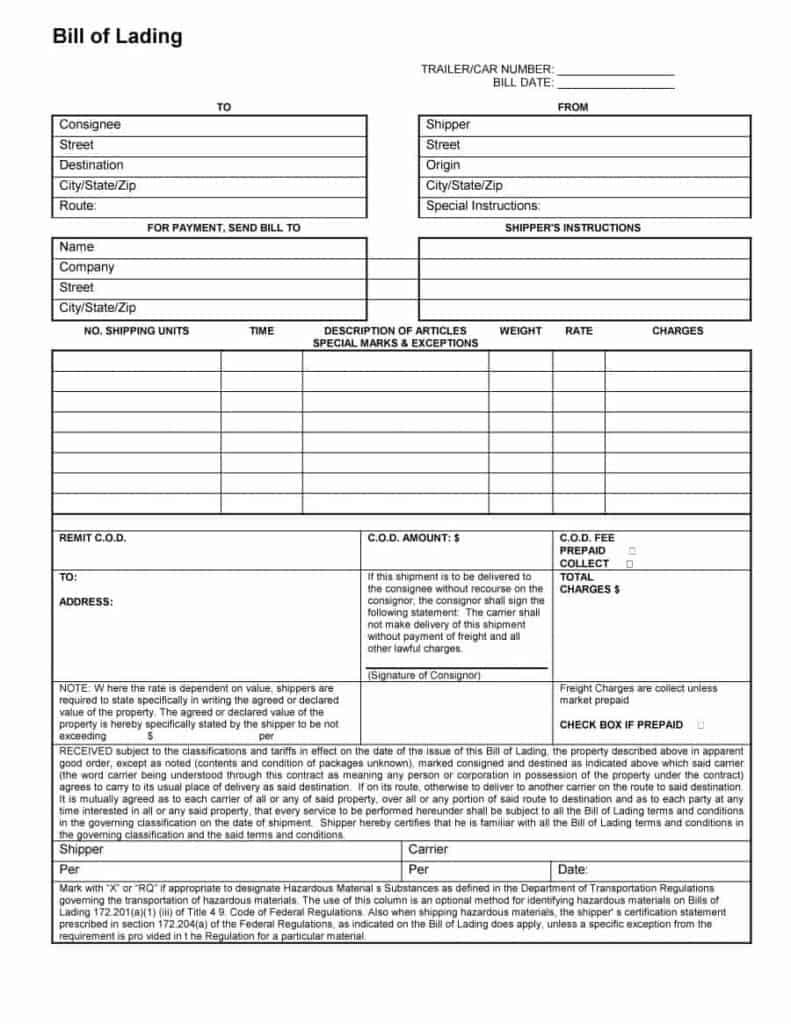Who issues bill of lading
The carrier issues the bill of lading when they take control of the goods. For everyone else who wants to understand that sentence in more detail—as well as the why and the responsible parties—read on! A bill of lading is a legal document that serves three core purposes during the freight of a product.
Although the term historically related only to carriage by sea, a bill of lading may today be used for any type of carriage of goods. Bills of lading are one of three crucial documents used in international trade to ensure that exporters receive payment and importers receive the merchandise.
The other two documents are a policy of insurance and an invoice. The traditional background to the issue of a bill of lading is as follows: (1) A person wishing to have goods carried by sea contracts with a carrier for their carriage, either by concluding a charterparty, or by concluding a more general contract of carriage in a booking note, exchange of correspondence or even by an oral contract.
When transporting by sea freight, the carrier can refer to the Shipping Line (Vessel Operating Common Carrier) or an NVOCC (Non-Vessel Operating Common Carrier) also known as a Freight Forwarde r (although not all Freight Forwarders are NVOCC’s). Bills of lading are issued every day, but the transportation professionals who truly understand their significance are in the minority.

With that in min we spoke with transportation law expert Brent Primus, J. CEO of Primus Law Office, P. CEO and senior editor of transportlawtexts, inc. An ocean carrier is someone who has undertaken to provide the transportation of goods from point A to point B using the waterways as the primary mode but also combining rail and road services. Bill of Lading and its purpose. It provides good evidence of the existence and terms of a contract between the shipper and carrier.
A contract of carriage may exist without issue of a bill of lading, however. Problems may arise handling a bill of lading. It’s a document to provide evidence or proof of shipment. This is extremely important in International Trade as it provides ‘title’ as to who legally owns the cargo.
The BoL is issued by the carrier. By way of simple summary of industry practice, upon shipment of a cargo a bill of lading is issued to the shipper who, once they receive payment, transfers the bill to the consignee, enabling them to take delivery of the cargo at the discharge port by presenting the bill of lading to the Master.
A transportation company or carrier typically issues this. The law requires the BOL to be issued by the carrier, as it is proof of their receipt of the goods. Fill out documents electronically using PDF or Word format. Make them reusable by generating templates, include and complete fillable fields.
Save forms on your personal computer or mobile device. What are bills of lading and how do they work.
If an individual receiver issues a claused bill of lading, the exporter may face future difficulty. The bill of lading is a contract that holds the details of what goods are being shippe and the terms and conditions agreed to between the. For example, if the goods arrive and the receiver deems them damaged or determines some of the.
This is where it can sometimes get tricky, especially if you have very specific information that you need on your BOL, such as specific order numbers, reference numbers, or elaborate descriptions. In the en a BOL can be created by one of three entities: the shipper, the carrier or the 3PL working on the shipper.
The parties can agree that the buyer – at their own cost and risk – will instruct the carrier to issue a transport document to the seller, stating that the goods have been loaded on-board. The product carrier issues a clean bill of lading after inspecting the goods.
If the bill of lading is "claused" or "fouled" when it notes that the products or goods are damaged or defective. Every export transaction uses a bill of lading. In regular shipping process, the release of goods to the consignee at destination occurs only upon surrender of one or more of these original Bills of Lading issued by the carrier.
Who issues a bill of lading ? The shipper, the carrier and the agent all know, or would be assumed to know, that in the vast majority of cases the bill of lading will be used to negotiate payment. The distinct defence of lack of authority to issue the bills of lading failed because the respective chief officer or cargo officer who signed the bills of lading (the “ Representatives ”) had actual authority to sign the bills on behalf of the master.
Our free TFG guide explains different scenarios for when BLs are require including FAQs on BLs. A freight forwarder’s bill of lading is a transport document which is issued by a freight forwarder. It is also known as a house bill of lading.

Make the most of a digital solution to develop, edit and sign documents in PDF or Word format on the web. Transform them into templates for multiple use, include fillable fields to collect recipients?
Yorumlar
Yorum Gönder